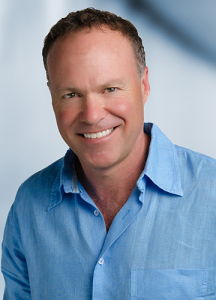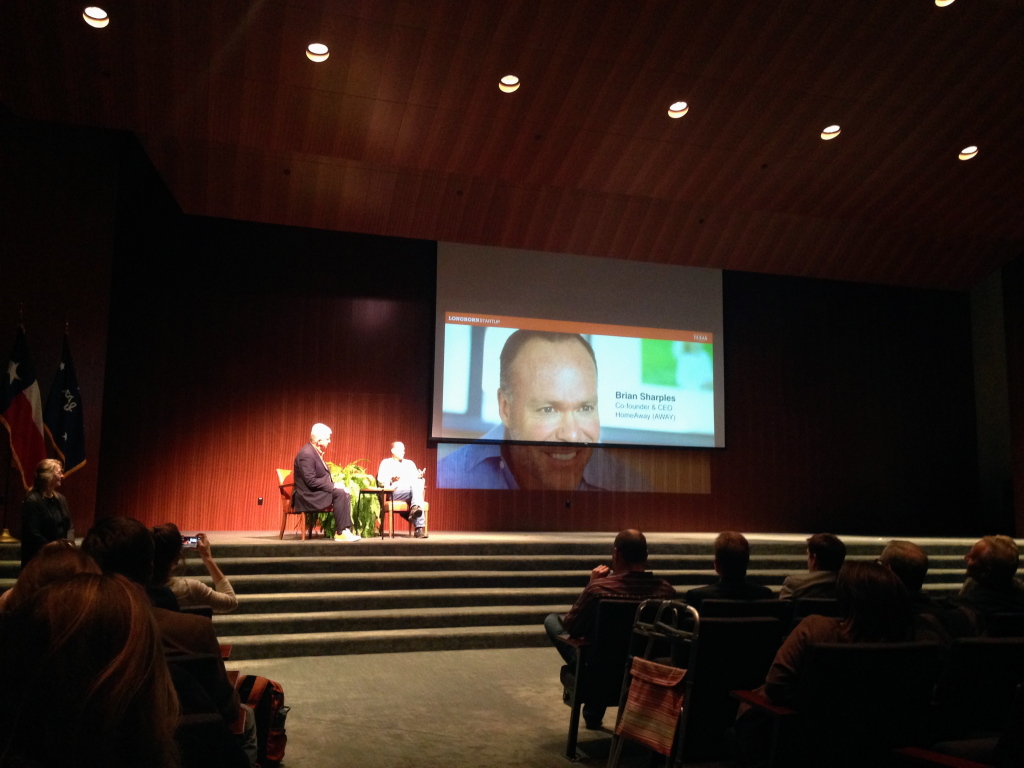By LAURA LOREK
Reporter with Silicon Hills News

Brian Sharples, courtesy photo from HomeAway
As a serial entrepreneur, Brian Sharples, co-founder of
HomeAway, has learned many lessons on his entrepreneurial journey.
He recounted several of them with Bob Metcalfe, professor of innovation at the University of Texas last week. Metcalfe interviewed Sharples, CEO of HomeAway at the Longhorn Startup Demo Day.
HomeAway has 1,900 employees worldwide, including about 1,000 in Austin in five locations. The company lists more than 1 million vacation rental homes in 190 countries. It went public in 2011 and has a market capitalization of $2.8 billion and its stock, listed as AWAY on the Nasdaq Stock Exchange, currently trades for around $30.50 a share.
The Early Years
First off, Metcalfe asked Sharples if he had a lemonade stand or paper route and to talk about his early entrepreneurial roots.
Sharples said he had done all of those things. And his entrepreneurial instincts came from his dad, who was an entrepreneur, electrical engineer and a pioneer in analog to digital conversion. He invented a digital panel meter. His invention is in the Smithsonian.
“He worked for himself, he didn’t have bosses, he had employees,” Sharples said.
Sharples grew up in an entrepreneurial environment in a suburb of Boston called Braintree. His family had a vacation house in Maine. He ended up attending Colby College in Maine and later got accepted to Stanford’s business school.
Grappling with Failure

Bob Metcalfe and Brian Sharples at Longhorn Demo Day
Metcalfe asked Sharples about his biggest entrepreneurial failure.
Sharples, at 27, raised $1 million from Kohlberg Kravis Roberts
Venture Capital Fund to create a marketplace for selling used autos. He rented out Candlestick Park in San Francisco and built a huge auto sales event for thousands of people.
“It was like a rock concert for buying cars,” Sharples said.
He bet all of his money on that first event. On a Saturday, they opened the doors and by 11 a.m. a freak storm with 85 mile per hour winds blew in and destroyed the place.
“It turned from a beautiful event one minute to how do we make sure no one gets killed,” Sharples said. “People got hurt but no one got seriously injured.”
Eventually, Sharples created iMotors, a derivative of that business, and ultimately raised $120 million and was doing $25 million in revenue by 1999. But when the dot com crash happened they couldn’t sustain the business. They ended up selling the assets for $85 million to AutoNation.
Moving to Austin
So Sharples decided to get out of the auto business. He moved to Austin and got involved with IntelliQuest, an 11-employee company providing Dell with market research information. Sharples got to know the founder really well. He ended up cutting a deal where Austin Ventures and Sharples each took a third of the company. They took the company public in 1996 and Sharples ran it for four years.
“One of the things I learned from that experience is it’s really nice to have a partner,” Sharples said.
In entrepreneurship, a lot of people associate that with being the lone wolf, Sharples said. But it’s a lot more powerful if you have a partner, he said. So when Sharples decided to launch HomeAway he wanted a partner and Austin Ventures introduced him to Carl Shepherd, a merger and acquisition expert who became co-founder of HomeAway.
In 2005, Sharples and Shepherd created HomeAway, then known as WVR, a global vacation home business. The idea was to create the Expedia of vacation rentals and to acquire great businesses around the world. Raised $405 million and did 22 acquisitions in total, Sharples said.
“HomeAway took a great deal of money to create,” Sharples said. And to get that kind of money, an entrepreneur has to have a track record of success and returning money to investors, he said.
The IntelliQuest Initial Public Offering and later sale to WPP Group made about a 25 times return on Austin Ventures investment, Sharples said.
“Once you’ve succeeded like that for investors, investors like to back people who have done it before,” he said.
Founding HomeAway
Austin Ventures agreed to back HomeAway for $50 million initially and they issued a press release saying they had given Sharples $50 million for a new venture. That check made people listen to them, Sharples said.
Sharples and Shepherd hired McGarrah Jessee, an Austin-based Ad Agency, to come up with the name HomeAway. The owner of the website domain name ended up being an RV park owner in the United Kingdom. They were able to negotiate with him and buy it, Sharples said.
Originally Sharples thought they would buy vacation properties around the world and rent them to club members. But through his research, he found there were 7 million homes alone in Europe for rent. It was a much bigger market. So they decided to build a platform and make the properties available to book online.
Before doing the platform, Sharples and Shepherd spent four months doing research on the project. They found out Expedia paid $73 million for a company that had the same model as HomeAway and a year later it was gone. So he met with Rich Barton, the CEO of Expedia, in Seattle and he took them through the entire deal. Expedia tried to turn the business into a hotel business. The homeowners viewed their homes as their personal property and they wanted to talk to people and they didn’t want to do everything online. The conversation was critical.
Within the next two years, everyone in the HomeAway marketplace will become online bookable, Sharples said. The marketplace has changed. It wouldn’t have worked ten years ago, or even five years ago, but it works now, he said.
Thinking About Worst Case Scenarios

Bob Metcalfe at Longhorn Startup Demo Day
Metcalfe pointed out that the Longhorn Startup class instructors teach their students to fail fast. But Sharples, he said, studies others who have failed and seeks to avoid the failure altogether.
Because of his first failure in the auto business, Sharples said he became paranoid and studied all the things that could go wrong in his next ventures.
He advised other startup entrepreneurs to study others, study worst case scenarios and think about risk.
“People spend so much time in their pitches on how everything could go right, they need to devote a little more time and scenario planning on how they could go wrong,” Sharples said.
For example, HomeAway bought Vacationhomes.com in the U.S. for $40 million just to prevent a competitor from buying it, Sharples said.
“We don’t just study failures of other companies, which we did in the early days, but we calculate all the ways we could fail and we try to prevent them,” Sharples said.
Sharples favorite recruiting question is to ask job candidates to talk about something they’ve failed about in their life. And the second question he asks is what did they learn from it.
He also looks for humility in his employees.
“I just don’t have the patience for ego,” Sharples said. “I think it sets up a horrible dynamic within a company when people are operating for personal gain or personal showboating. I’m all for being super competitive. But within a team, you can’t be super competitive. Building a company is a team sport.”
The introduction song for Sharples when he entered the stage was Rusted Root’s “Send Me on My Way,” which he says they may use in their next commercial campaign because it sounds like HomeAway.
![]() Revionics, a retail software maker, has announced it raised $30 million in venture capital from Goldman Sachs.
Revionics, a retail software maker, has announced it raised $30 million in venture capital from Goldman Sachs.
